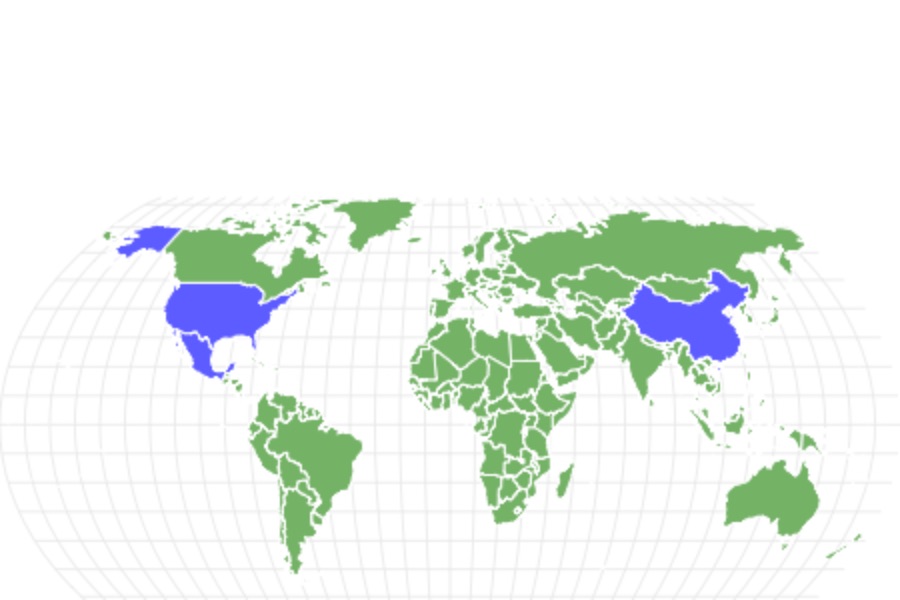Dire Wolf
Advertisement
Dire Wolf Scientific Classification
- Kingdom
- Animalia
Read our Complete Guide to Classification of Animals.
Dire Wolf Conservation Status
Dire Wolf Facts
- Diet
- Omnivore
Dire Wolf Physical Characteristics
View all of the Dire Wolf images!
Aenocyon dirus, the dire wolf, was a massive carnivore during the Late Pleistocene and Early Holocene epochs. This means they lived sometime between 125,000 and 9,500 years ago. Although they weighed up to 200 lbs., these relatives of the gray wolf (Canis lupus) were about 25% larger than the biggest modern wolf species. In fact, they measured up to 39 inches at the shoulder and 69 inches in length.
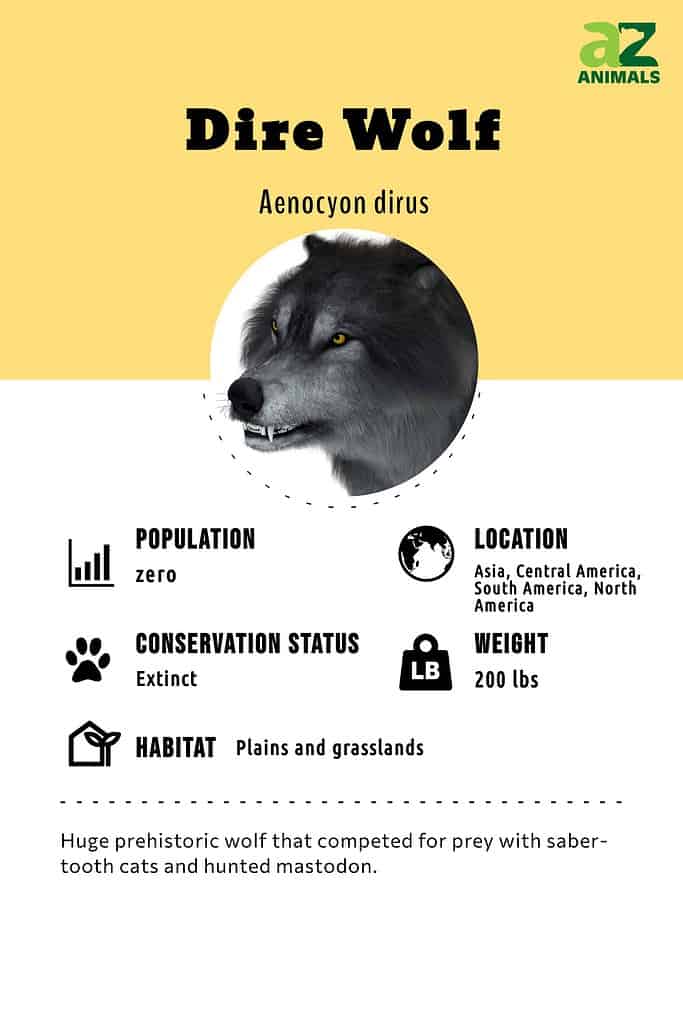
New Evidence Led to Reclassification
It is important to know that these massive wolves were once classified in the genus Canis. Since that time, scientists have been able to sequence the dire wolf’s DNA from fossils discovered in North America. This sequencing shows that these animals are genetically unique when compared to members of the genus Canis. The large prehistoric wolves may have looked much like gray wolves, but they could not have interbred with them or other members of that genus. Jackals are closer relatives to the dire wolf. The similar morphological characteristics between dire wolves and gray wolves may be a result of convergent evolution and not a shared ancestry. For this reason, scientists have now reclassified the dire wolf into its own genus, Aenocyon. Aenocyon comes from the Latin words ainos, meaning “terrible,” and cyon, meaning “dog.” Dirus is from the Latin term for “ominous.”
Subspecies
There are at least two subspecies of dire wolf,Aenocyon dirus:
- Aenocyon dirus guildayi is the smaller of the two subspecies and could be found west of the Rocky Mountains in North America.
- Aenocyon dirus dirus is the larger of the two subspecies and could be found east of the Rocky Mountains in North America.
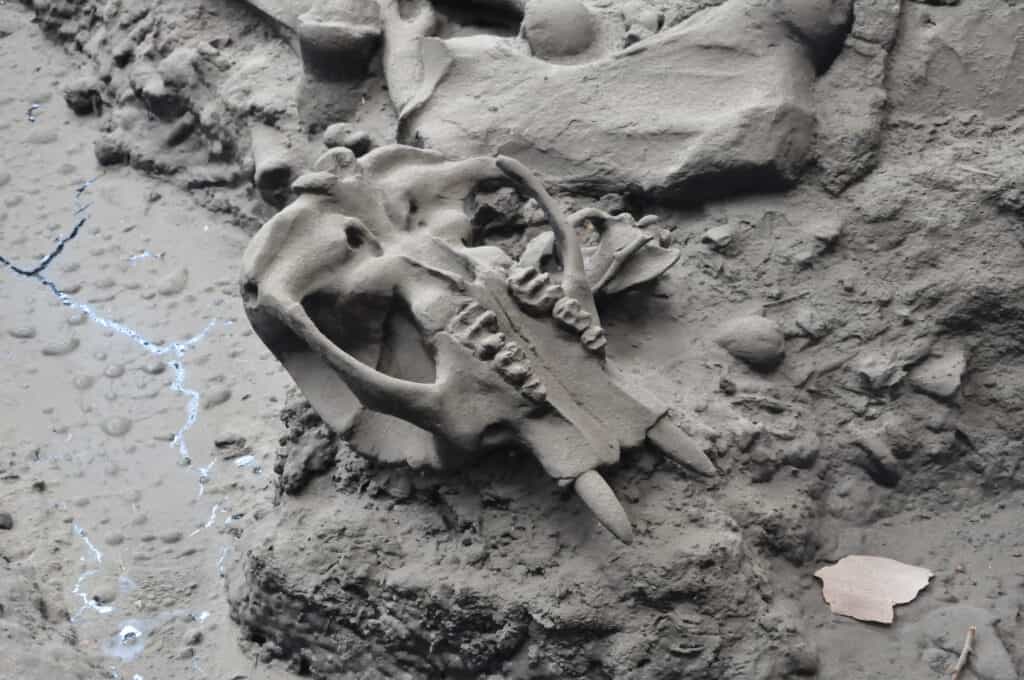
Fossils in La Brea tar pits have contributed to the reclassification of the dire wolf.
©DanielMcHenry/Shutterstock.com
Evolution
It is now believed that dire wolves descended from a carnivore lineage going back 5 million years ago in North America, instead of the previous theory of the animal descending from wolf-like canids that spread from Eurasia into the Americas around 1 million years ago.
Fossils of dire wolves have been found all across North America and into South America. In the United States, fossils have shown that the animal was adapted to multiple habitats, from grasslands, and coastal open woodlands to tropical wetlands. In South America, fossils dating to about 17,000 years ago have been found in Venezuela, Peru, and Bolivia. A partial jaw of a dire wolf was recently identified in China, suggesting that the animal crossed the Bering Land Bridge into Asia from North America – instead of the other way around.

Dire wolves were roughly the size of the extant gray wolf, but with a heavier build.
©iStock.com/Aunt_Spray
5 Cool Facts About Dire Wolves
- Today’s gray wolf (Canis lupus) is an ancestor of the extinct dire wolf but the African jackal is more closely related.
- Thousands of dire wolf and sabretooth tiger fossils were found In the same habitat fossilized in the La Brea Tar Pits of Los Angeles.
- Like modern-day dogs and cats, these wolves were hyper-carnivores, meaning their diet consisted of at least 70% meat.
- These wolves were 25% bigger than today’s largest gray wolves, weighing up to 200 pounds.
- Despite this animal going extinct at the end of the last Ice Age, scientists believe they have enough of the wolf’s DNA to bring it back to life one day.
Diet – What Did the Dire Wolf Eat?
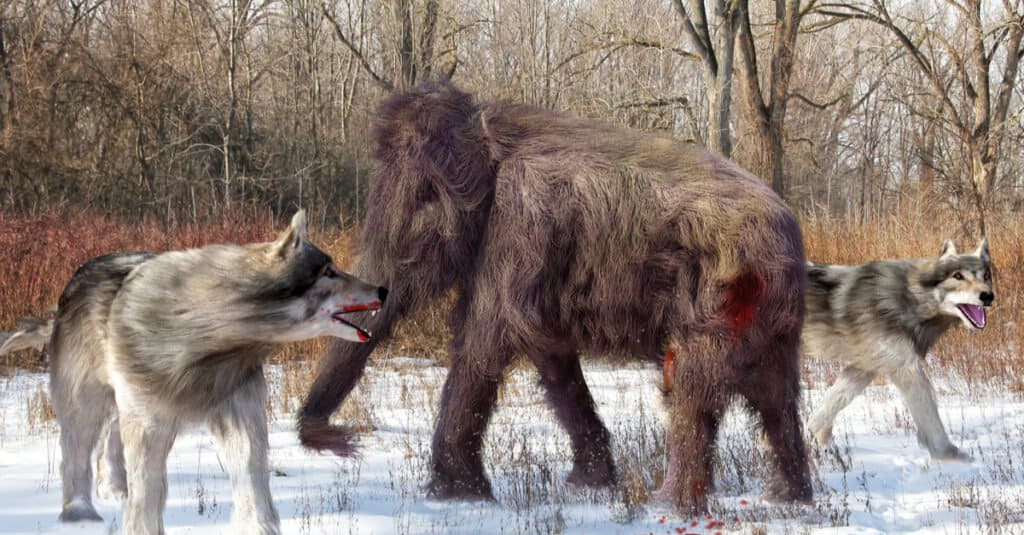
Dire wolves preyed on prehistoric mammals such as sloths, mastodons, horses, and bison.
©Aunt Spray/Shutterstock.com
This wolf was a hyper-carnivore, just like modern cats and dogs. This means these prehistoric mammals enjoyed a diet of at least 70% meat. Their prey included horses and pronghorn deer. They would also sometimes eat sloths, mastodon, wooly rhinoceros, bison, and camel. As food became scarce and the dire wolf species struggled to find prey, they would eat just about any herbivore they could find. At the end of their era, the dire wolf was in competition with humans, gray wolves, and other carnivores for the same prey.
Dire wolves were about 25% bigger than the biggest modern gray wolf. At the same time, these larger prehistoric wolves also had a much larger skulls with 29% more biting power than today’s wolves. Overall, their teeth were sharper and better at slicing into the meat. But the canine teeth were more rounded, enabling them to crush bone and more easily feed on nutrient-packed marrow from their prey. Dire wolves hunted prey ranging from 600lbs. to more than 1,300lbs. They could take down prey more than 6 times their body weight.

Scientists believe the wolves hunted in packs, much like today’s gray wolves. They came to this conclusion because thousands of the species were fossilized in the La Brea Tar Pits of Los Angeles. There, natural historians found evidence of wolves working together for hunting. They were in direct competition with other vicious species like sabretooth tigers and American lions.
Habitat – When and Where the Dire Wolf Lived
The dire wolf was able to live in a wide range of habitats and environmental conditions throughout North America, South America, and east Asia. They lived between 125,000 and 9,500 years ago during the Late Pleistocene and Early Holocene epochs. They became extinct sometime after the last Ice Age. The animal’s preferred habitats were plains and grasslands in North America. In South America, they lived in the arid savannah.
U.S. states where dire wolves lived include:
- Arizona
- California
- Florida
- Idaho
- Indiana
- Kansas
- Kentucky
- Missouri
- Nebraska
- New Mexico
- Nevada
- Oregon
- Pennsylvania
- South Carolina
- South Dakota
- Texas
- Utah
- Virginia
- West Virginia
- Wyoming
Threats And Predators
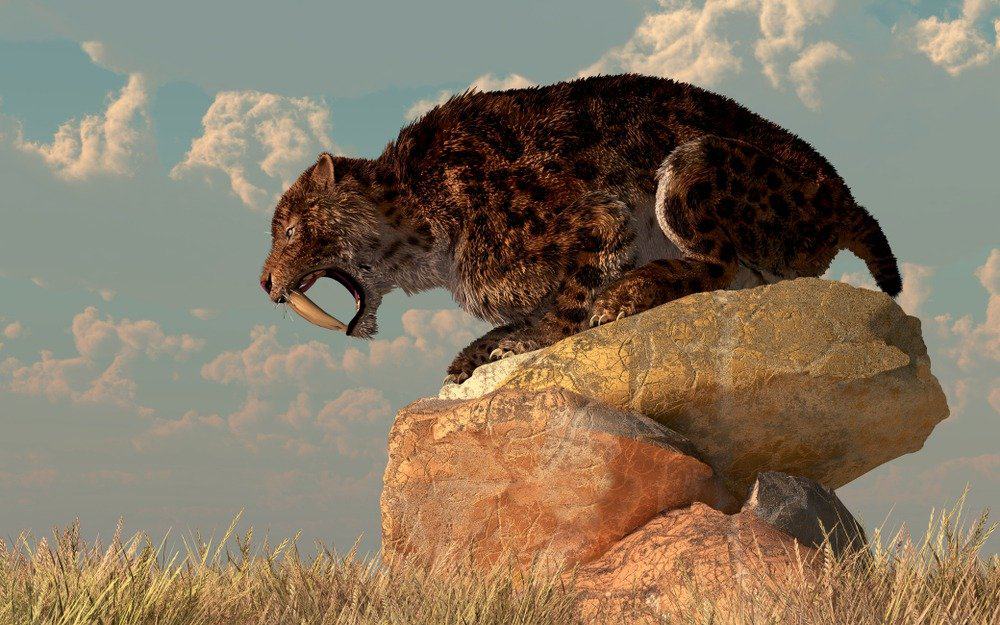
Dire wolves and saber-toothed cats competed for food and became extinct around the same time.
©Daniel Eskridge/Shutterstock.com
Dire wolves were widespread apex predators. This means they did not have natural predators of their own, like the modern-day grizzly bear. But they competed for food with sabretooth tigers and, toward the end of their existence, humans.
The biggest threat to dire wolves was competition for food and the eventual scarcity of prey. Over time, humans became better hunters and were more successful in taking down large herbivores that the dire wolf fed upon. Dire wolf fossils in La Brea tar pits of Los Angeles were found alongside sabretooth tigers, leading scientists to theorize competition for food was a big issue between these two species of carnivores and others like them. This is made further evident by changes in the teeth of fossils from 15,000 to 12,000 years ago. At this time, the dire wolf started experiencing more frequently broken teeth due to increased bone marrow in its diet. The more common gnawing on bones indicates they needed to work harder for their nourishment.
Discoveries and Fossils – Where It Was Found
Thousands of fossilized dire wolf specimens have been found in North America, Mexico, South America, and even China. The La Brea Tar Pits in downtown Los Angeles is one particularly fossil-rich site for these prehistoric canines. This site and others like it indicate the animals lived mostly in open lowlands where they had access to large herbivores as prey. Few fossilized remains have been found beyond northern California’s latitude of 42°N, although there is evidence that the wolves ventured into and even lived in southern Canada.
Extinction – When Did It Die Out?
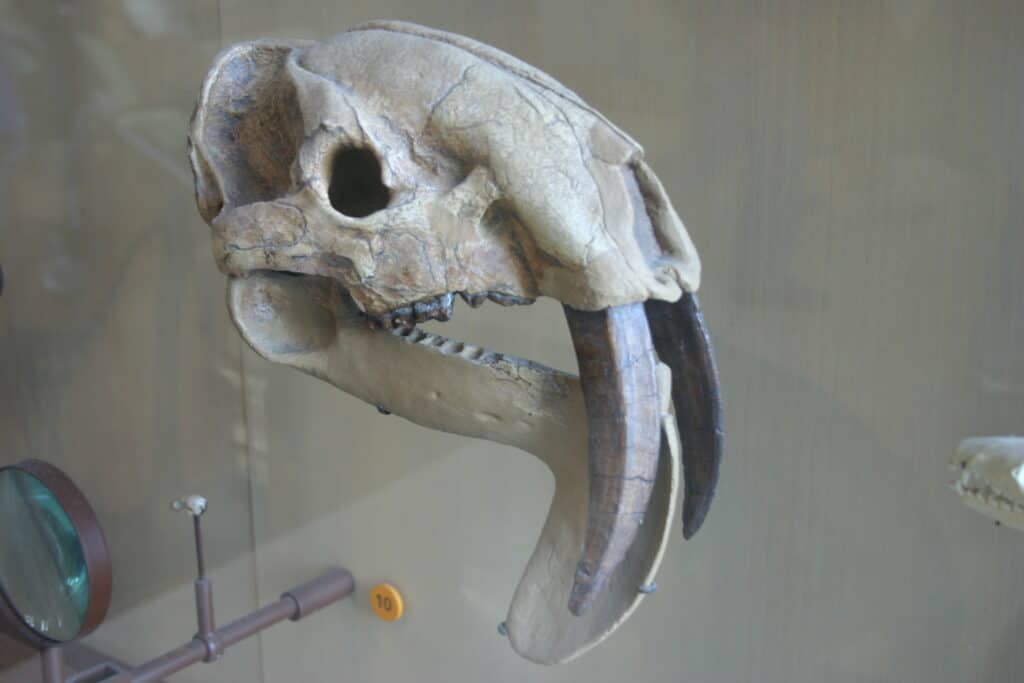
Fossils of saber-tooth cats have been found alongside dire wolves in the La Brea Tar Pits.
©Ideonexus/CCBYSA2.0 – License
The dire wolf became extinct at the same time as many other species, during the Quaternary extinction event of 13,000 BCE to 8,000 BCE. The last prehistoric wolf is believed to have disappeared sometime around 9,500 years ago.
The migration of humans and increased competition for food are believed to be two major causes for this extinction. Humans preyed upon the same herbivores as the wolves and became increasingly better at hunting, making it harder for the dire wolf to find enough food. During this same time, about 90 other types of large mammals weighing over 97 lbs. became extinct.
Similar Animals to the Dire Wolf
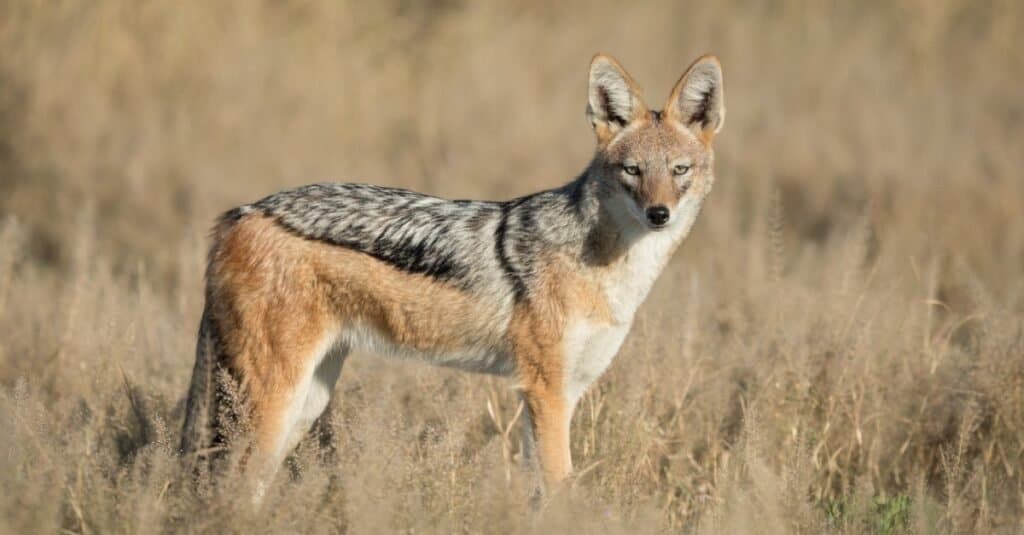
African jackals are close relatives of the dire wolf.
©iStock.com/StuPorts
Similar animals to the dire wolf include:
- Sabretooth tiger – Another apex predator, the sabretooth tiger often competed with the dire wolf for food
- African jackal – This carnivore shared DNA with the dire wolf and lived from 5.1 million years ago through modern day
- Pleistocene wolf – With its lineage of gray wolves still thriving today, the prehistoric gray wolf and dire wolf shared similar skeletal structure
Dire Wolf FAQs (Frequently Asked Questions)
When was the dire wolf alive?
The dire wolf lived from 2.6 million to 11,700 years ago during the Pleistocene Epoch. This was the time during which the last ice age occurred, covering vast parts of the Earth with glaciers.
How big was the dire wolf?
This prehistoric predator was about 25% larger than the biggest gray wolves of the modern era. They weighed between 150 and 200lbs. They stood at about 38 inches at the shoulder and had a body length of about 69 inches.
Why did the dire wolf go extinct?
Around 13,000 years ago, large mammals that were the dire wolf’s main source of food became extinct or became much harder for the carnivore to find. Scientists believe that because the wolf could not find its prey, it also became extinct.
Is the dire wolf real?
Dire wolves were real. They are extinct today, but lived about 9,500 years ago. They went extinct as their food sources also became increasingly scarce or extinct due to human and other species’ hunting. They were massive wolf-like creatures related to the gray wolf.
How strong was the dire wolf's bite?
The dire wolf was about 25% larger in body size when compared to today’s gray wolf. The dire wolf also had a much bigger bite than their modern-day relatives. This bite was 29% stronger than the gray wolf’s biting force. The dire wolf had razor-sharp teeth designed to cut into and tear away the meat of its prey. Its bite was also bone-crushing, enabling the prehistoric wolves to get essential nutrients from bone marrow.
What did the dire wolf eat?
The dire wolf was a hyper-carnivore. This means that meat made up at least 70% of the prehistoric wolf’s daily diet. They preferred to feed upon large herbivores like the bison, horse, pronghorn, ground sloth, mastodon and mammoth. The wolves did not just eat their prey’s meat. They also bit into bones to feast on nutrient-rich marrow. Their canine teeth were rounded to provide more force for crushing bones.
Where did the dire wolf live?
The dire wolf lived in North America, South America and east Asia. Their fossilized remains have been found in many U.S. states, Canada, Mexico, South America and China. Their prime habitat and hunting grounds included grassy plains, savannahs and forests at the base of mountains.
Thank you for reading! Have some feedback for us? Contact the AZ Animals editorial team.
Sources
- The New York Times, Available here: https://www.nytimes.com/2021/01/13/science/dire-wolf-genome.html
- Dire Wolf Project, Available here: https://direwolfproject.com/dire-wolf/dire-wolf-appearance/
- Illinois State Museum, Available here: http://iceage.museum.state.il.us/mammals/dire-wolf-0
- Thought Co., Available here: https://www.thoughtco.com/facts-about-the-dire-wolf-1093336
- Indiana University, Available here: https://igws.indiana.edu/FossilsAndTime/DireWolf
- Scientific American, Available here: https://www.scientificamerican.com/article/dire-wolves-were-not-really-wolves-new-genetic-clues-reveal/
- The Conservation, Available here: https://theconversation.com/dire-wolves-went-extinct-13-000-years-ago-but-thanks-to-new-genetic-analysis-their-true-story-can-now-be-told-153223
- Wikipedia, Available here: https://en.wikipedia.org/wiki/Dire_wolf
- Britannica, Available here: https://www.britannica.com/animal/dire-wolf
- National Park Services, Available here: https://www.nps.gov/articles/000/dire-wolf.htm
- National Park Services, Available here: https://www.nps.gov/whsa/learn/nature/dire-wolves.htm
- Science, Available here: https://www.science.org/content/article/legendary-dire-wolf-may-not-have-been-wolf-all
- Nature, Available here: https://www.nature.com/articles/s41586-020-03082-x
- National Geographic, Available here: https://www.nationalgeographic.com/animals/article/dire-wolf-dna-study-reveals-surprises
- San Diego Natural History Museum, Available here: https://www.sdnhm.org/exhibitions/fossil-mysteries/fossil-field-guide-a-z/dire-wolf/

